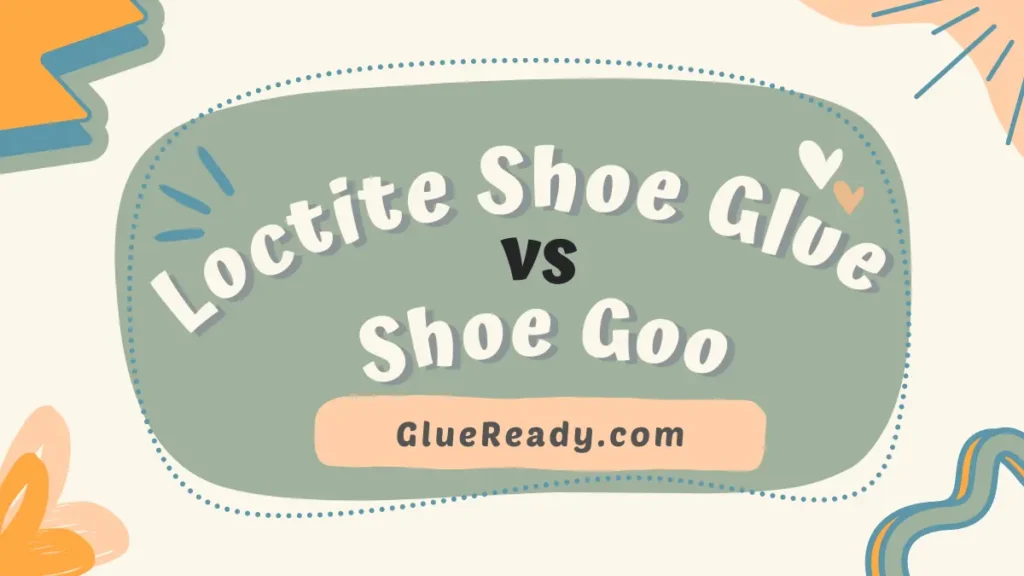Shoe Goo vs Rubber Cement

Shoe Goo and Rubber Cement are both adhesives that can be used for repairing shoes.
Shoe Goo is an adhesive made specifically for repairing different shoe components, while Rubber Cement is primarily used for arts and crafts projects but can also be used to repair various parts of shoes like heels.
In the battle between shoe goo vs rubber cement, I will try to help you to find an appropriate solution in this article.
Read More: Top 4 Best Rubber Cement
Understanding Shoe Goo
Shoe Goo has gained a reputation as a go-to adhesive for shoe repairs due to its specialized formulation.
This flexible and durable adhesive is specifically designed to mend various materials commonly found in shoes, such as rubber, leather, vinyl, and canvas.
Its exceptional flexibility ensures that repairs hold up even in high-stress areas like shoe soles and heels, where constant movement is prevalent.
Furthermore, Shoe Goo boasts excellent water resistance, making it an ideal choice for protecting shoes against the elements.

Understanding Rubber Cement
Rubber Cement offers a versatile adhesive solution suitable for various craft and temporary bonding projects.
Comprising rubber particles or synthetic rubber dissolved in a solvent, Rubber Cement creates a repositionable adhesive layer that allows for easy adjustments before the adhesive fully sets.
This quality is particularly valuable in arts and crafts projects where precise positioning and temporary bonding are crucial.
Rubber Cement is a staple for activities such as collages, scrapbooking, and mounting photos.

Shoe Goo vs Rubber Cement Comparison Table
| Feature | Shoe Goo | Rubber Cement |
| Type of Adhesive | Rubber cement | Rubber cement |
| Purpose | Repairing shoes | Various purposes, including shoe repair |
| Drying Time | 24 hours | Sets in 15 Minutes |
| Water Resistance | High | Low |
| Toxicity | High (contains toluene and solvent naphtha) | Low (contains less toxic solvents) |
| Materials to use on | Leather, vinyl, rubber, canvas, etc. | Paper, wood, metal, glass, etc. |
Comparison Between Shoe Goo and Rubber Cement
Shoe Goo and Rubber Cement have some similarities, but they also have some significant differences that affect their performance and suitability for shoe repair.
Here are some of the main differences between them:
Appropriate Materials
Shoe Goo is specifically made for repairing shoes and works well with most shoe materials, such as leather, vinyl, rubber, and canvas.
Rubber Cement is more versatile and can bond various surfaces, but it may not be as effective or compatible with some shoe materials.
Drying Time
Shoe Goo has a longer drying time than Rubber Cement.
Shoe Goo takes about 24 hours to cure completely, while Rubber Cement takes about 15 minutes to set.
This means that Shoe Goo gives you more time to adjust the glue before it dries, but it also means that you have to wait longer before you can use your shoes again.
Rubber Cement dries faster, but it also requires more precision and accuracy when applying it.
Water Resistance
Shoe Goo is more water-resistant than Rubber Cement.
Shoe Goo can withstand exposure to water and moisture without losing its strength or flexibility.
Rubber Cement may weaken or dissolve when exposed to water or moisture.
Health and Safety
Shoe Goo contains toluene and solvent naphtha, which are flammable and toxic substances that can cause irritation or damage to the skin, eyes, respiratory system, nervous system, or liver if inhaled or ingested.
Rubber Cement also contains solvents that are flammable and harmful if inhaled or ingested.
Both adhesives should be used with caution and in well-ventilated areas. They should be kept away from children and pets.
Know More: Shoe Goo vs Contact Cement
Choosing the Perfect One Between Shoe Goo and Rubber Cement
To select the most suitable adhesive for your project, consider the following factors:
Application
If you’re repairing shoes, Shoe Goo’s flexibility and durability are unmatched.
For arts and crafts or temporary bonding needs, Rubber Cement’s repositionable nature makes it an ideal choice.
Materials
Determine the materials you need to bond. Shoe Goo excels at shoe-related materials, while Rubber Cement is versatile for lightweight materials like paper and cardboard.
Longevity
For long-lasting repairs, Shoe Goo is designed to withstand the stress and movement that shoes endure.
Rubber Cement is more suited for temporary bonds.
Weather Resistance
If your project will be exposed to the elements, Shoe Goo’s water resistance provides added durability.
Flexibility
Shoe Goo’s flexibility ensures that bonded areas won’t easily crack or detach during movement.
Frequently Asked Questions (FAQs)
Will Shoe Goo Work on Rubber?
Yes, Shoe Goo works great on rubber and can fix and repair rubber boots and soles.
When Shoe Goo is fully cured, it is completely waterproof, so it can be used on rubber boots, you use during wet weather and rainy days.
Is Rubber Cement Good for Shoe Soles?
Rubber Cement can be used to repair shoe soles, but it is not the best option.
Rubber Cement is primarily used for arts and crafts projects and is not as durable as other adhesives like Shoe Goo, which is specifically designed for repairing shoes.
Final Thoughts
Shoe Goo and Rubber Cement are both useful adhesives that can help you repair your shoes. However, they have different properties and applications that may suit different needs and preferences.
If you want a flexible, durable, and water-resistant glue that can work with different materials, Shoe Goo might be a better option.
If you want a fast-drying, rigid, and easy-to-remove glue that can work with plastics and metals, Rubber Cement might be a better option.
Hopefully, you find this article about shoe goo vs rubber cement informative and helpful in deciding the best one for your next project.






